Boat Bill of Sale Form
A boat bill of sale is a type of legal documentation used when passing on a vessel (with or without a motor) from one person to another – that is, from the seller to a buyer. This legal document must include detailed prices if an outboard motor or trailer is a part of the sale. The bill of sale for a watercraft must be completed and signed only by the people involved in the deal once the seller has presented the boat and the buyer has made the payment.
Why Use a Boat Bill of Sale?
It is usually required that a person who has recently purchased a boat gets the ownership of the vessel as well as its registration under a new name.
Use a watercraft bill of sale to ensure that you have proof that the sale occurred on agreed terms. This legal document also confirms that the seller initially owned the boat and they decided to transfer the title to the buyer. A boat bill of sale also features a detailed description of the boat being sold (year of manufacture, model, brand, serial number, etc.). It serves as the evidence of the watercraft being in a particular condition when transferred to the customer.
Types of boats that might be acquired or sold with the help of this document include vessels like a canoe, fishing boat, yacht, cabin cruiser, sailboat, kayak, and other flotation devices for marine enthusiasts.
Boat Bill of Sale Form Details
| Document Name | Boat Bill of Sale Form |
| Other Names | Vessel Bill of Sale, Watercraft Bill of Sale |
| Avg. Time to Fill Out | 14 minutes |
| # of Fillable Fields | 79 |
| Available Formats | Adobe PDF; Microsoft Word |
Can I Create a Boat Bill of Sale Online?
By analogy with all legal documentation, a boat bill of sale form may appear to be too elaborate and confusing for the seller to create on their own. For this reason, we present everyone looking for a vessel bill of sale with a topnotch sale form, which you can quickly and effortlessly download from our site. After that, you may create your own boat bill of sale with any additional terms and conditions you want to include. All versions of such a bill of sale template are given in the most popular formats supported by Microsoft Word and PDF readers, and they are available for free download. By using our form, you can add any related information and rules you want as well as avoid being perplexed by the complex terminology of this legal document. Include all the information you need in the form, fill out all of the necessary blanks, and print it out for further use.
Besides that, you may enjoy the help of our reliable stage-by-stage builder to create an incredibly personalized boat bill of sale form.
Of course, you may also address a lawyer specializing in a bill of sale for a boat and receive a detailed consultation on this matter. This will undoubtedly cost you some money, and that is not the most profitable way to sell your vessel. Nonetheless, legal professionals have enough knowledge and skills to write a high-end watercraft bill of sale form for you. Another minor inconvenience of such an option is that you will be required to come up with a sales price, providing your full name and other vital information regarding the sale of your boat in advance. If you are planning to put up at least a couple of boats for sale, you will have to provide a thorough description of these boats including their condition along with their current state.
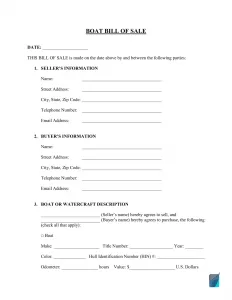
How Do I Sell a Boat?
When you have decided to offer your vessel for sale, it is crucial to prepare for such a deal properly. Before you learn what a boat bill of sale should include, follow our comprehensive guide on selling a watercraft.
Step 1. Make Your Boat Look Presentable

Before presenting your vessel to the public, you must ensure that it is in excellent condition. Begin with eliminating any messes inside the boat. If your yacht or motorboat comes with a cabin, clean the interior surface from top to bottom with household cleaning agents and vacuum the floors. Then you will need to clean the outer surface of your boat. Start by washing the deck and going down to the hull to scrub off any dirt caused by water. Resort to a power washer if you cannot get rid of more persistent dirt.
To ensure that your boat will catch the eye of a prospective buyer, inspect it for breakages, scratches, and other damage. Analyze whether it is convenient for you to spend time and money eliminating defects in the pursuit of a higher purchase price. Certain flaws can be promptly repaired for a small price, while others, as you may think, will reduce your profit.
Step 2. Collect the Boat’s Documents
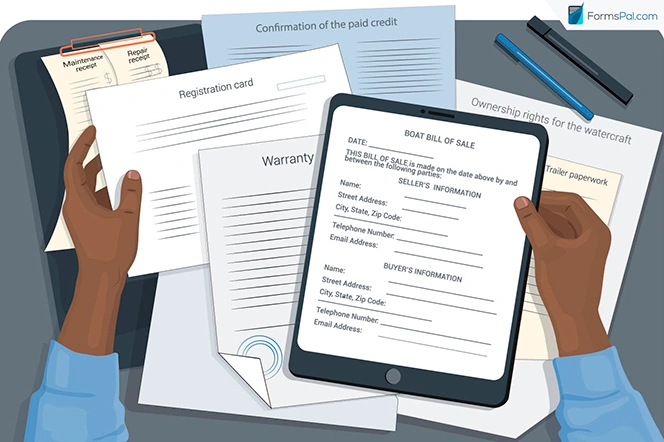
Besides a vessel bill of sale, there are several documents that the seller must provide when getting prepared to sell their watercraft. Hence, be sure you have the following documentation when signing the deal:
- A bill of sale form. Come with a couple of blank copies to complete and sign them on the day of the sale. Both the seller and buyer must have a copy of such a legal document.
- Ownership rights for the watercraft. This certificate will be given to the purchaser at the time of sale.
- Registration card. Unless your vessel is exempt from registration, you will have to provide the new owner with a copy of the boat’s most recent registration card.
- Confirmation of the paid credit. In case your boat’s purchase was funded by a financial organization, you will want to present a document serving as proof that you have reimbursed the lender.
- Trailer paperwork. When you wish to sell the trailer you use to tow the vessel as well, you will need to collect the title to it and its registration card.
- Maintenance and repair receipts. Collect all documentation concerning the enhancements made to your boat.
- Warranty. If a guarantee accompanies the boat, be sure to provide corresponding documents.
Step 3. Decide on the Price

One more crucial thing to figure out is the selling price. After you have cleaned up your yacht or sailboat and have collected all of the critical paperwork, you need to come up with the appropriate cost of the boat. There are several aspects that you will have to consider when deciding on the price of your watercraft. First, you must give an honest assessment of its condition. Is the condition poor, fair, good, or great? The better its condition, the higher price you can potentially set. After that, browse ad platforms to get an idea of the current situation on the market. Viewing ads for similar watercraft can help you estimate the cost of your boat. Some web resources offer convenient pricing tools, the most popular among them being NADAguides.com, where you can enter particular information regarding your jet ski or kayak and the website’s system will generate an approximate price for you.
Step 4. Put Your Boat Up For Sale
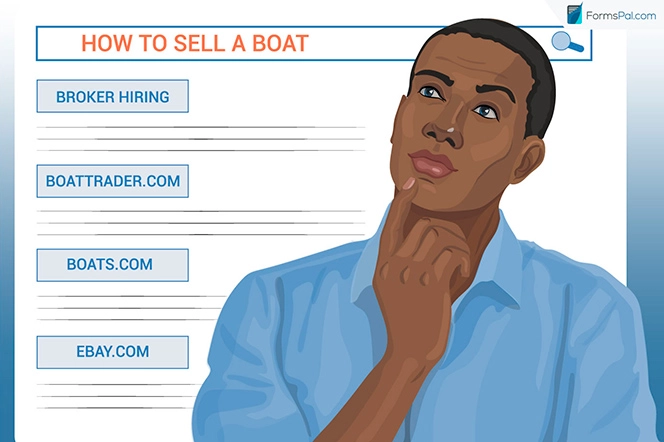
Next, as a seller, you should decide whether you need a broker’s assistance or not. There are two options the seller can resort to when listing their boat:
1. Hiring a broker. Usually, if the boat is sold for more than $40,000, it is recommended to get the competent help of a broker at the local pier. They will not only offer it for sale at fair market value but will also clean and present it to every prospective buyer.
2. Selling it yourself. When the cost is under $40,000, then it is better to sell the boat yourself. The majority of brokers won’t work with a water vessel lower than this amount. If the seller decides to advertise the boat on their own, it is best to resort to the following platforms:
- BoatTrader.com
- Boats.com
- eBay.com
Before you even consider putting your yacht or motorboat up for sale online or with a broker, it is a great idea to brush it up by doing expensive repairs or hiring a cleaning service to get the best opportunity to sell your boat.
Step 5. Show the Boat to Potential Customers

In case your sailboat or cabin cruiser is located in another state, it might be a challenge to present it to each potential buyer. Yet, one way or another, you will need to advertise it in person. For instance, if your boat is being moored, it will be more difficult for prospective customers to look at its exterior since you will have to lift people on and off your watercraft every time someone wants to look at it. The optimal solution is to put your boat on the dock for easy access so buyers can get an accurate idea of what it is like to be on your vessel in the water.
If docking is out of the question, the next best and cheapest way to present your boat is to park it on land. Either place it on a trailer or mount on a stand.
Step 6. Discuss the sale

After someone has expressed interest in acquiring your boat, it is best to sit down and negotiate the deal and its conditions. The first obstacle will be the price. Many times, the buyer will try to fetch a reduction in the initially set price in an attempt to save money. It will raise the question of whether the seller would want to accept, reject, or make a counteroffer.
When both the seller and customer reach an agreement, it is vital to decide which kind of payment will be used for the sale. The seller typically prefers cash or a certified check. If opting for a certified check, you may go one step further and meet the buyer at their bank to ensure that this form of payment will clear. Once the buyer has provided money, the seller will give them all important paperwork and the keys to their new vessel.
How to Fill Out a Vessel Bill of Sale
As you already know, the boat bill of sale is significant for the customer if they want to confirm that the title to a watercraft has been legally passed on to them. Such a bill of sale form used to transfer the ownership right of a vessel from the seller to the customer has to include the following information:
- The date of the sale
- The seller’s and buyer’s details
- Full name
- Address
- Phone number
- Detailed vessel information
- Model
- Year
- Title number
- Color
- Hull identification number
- Engine hours
- Value
- (If added to the deal) Trailer and outboard motor(s) details
- The purchase price(s) and methods (in U.S. currency) negotiated by the seller and customer
- The buyer’s signature
- The seller’s signature
- Signatures of the witness(es) and their printed name(s)
- Date of signatures
- Notary acknowledgment
How to write a Boat Bill of Sale?
Down below, you will take a look at the directions written by drawing upon the boat bill of sale form developed by our specialists. We strongly advise using your local official document whenever possible.
Step 1: Specify the document’s creation date.

Step 2: Type in the buyer’s and seller’s particulars:
- Full legal name
- Address: Street, City, State, Zip code
- Contact details: Contact number, Email address

Step 3: Fill in the details regarding the boat that you are trying to sell.
- Manufacturer
- Title number
- Year
- Boat Color
- Hull Identification Number (also known as HIN)
- Odometer measurement (in hours)
- Dollar value
Here, you should also indicate whether or not your boat will come with a trailer and/or motor(s). If so, put the details of the needed element in the respective field. For a trailer, you will need to specify:
- Make
- License plate number
- Color
- VIN
- Year
- Value (in dollars)
If your boat is supplied with a motor or motors, enter the following information for every single motor your boat is equipped with.
- Make
- Horsepower
- Serial Number
- Value (in dollars)
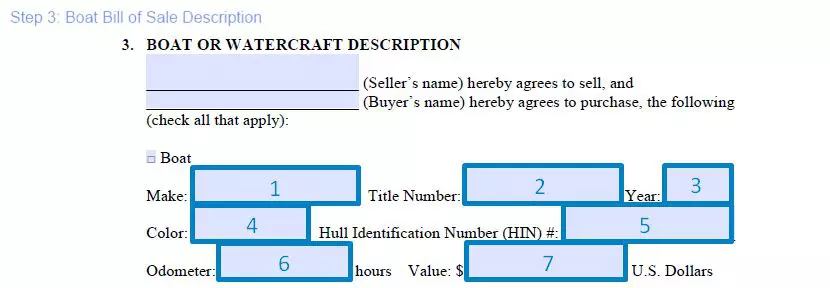
Step 4: Now, you will need to indicate how you’ll be given money for the boat.
Type in the transaction date and specify the overall amount that has to be paid for the boat. Then, decide on one selling method:
- One-time payment. Nothing complicated here: the individual pays the total sum in a single payment and has the boat or watercraft delivered to them on the same day.
- Installment payments. Enter the down payment amount as well as the exact date it has to be paid, along with the date by which the full sum has to be transferred to the property owner.
- Gift with no consideration paid. It means that the seller gives their boat as a gift without any monetary compensation expected from the purchaser.
Following that, choose one payment method (except for when you choose a gift option):
- Cash
- Check
- Cashier’s cheque
- Money order
As a final point, indicate if the purchase cost contains all applicable taxes.
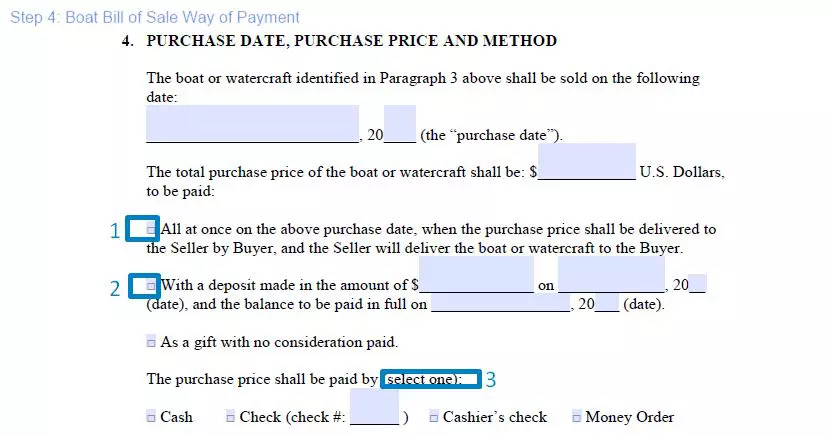
Step 5: Read through the miscellaneous terms.
The “as-is” provision indicates that the boat owner gives no warranties and is not liable for maintenance after the transfer.
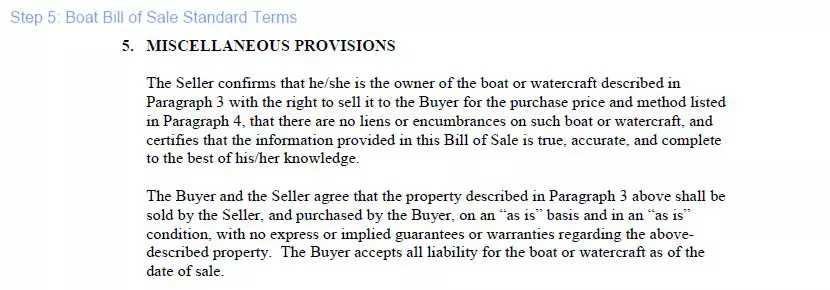
Step 6: Put your signature(s) in the corresponding areas.
The buyer is typically not required to sign a boat bill of sale. However, it’s advised to get the form signed by both parties. You may additionally have one or a few witnesses confirm the transaction.
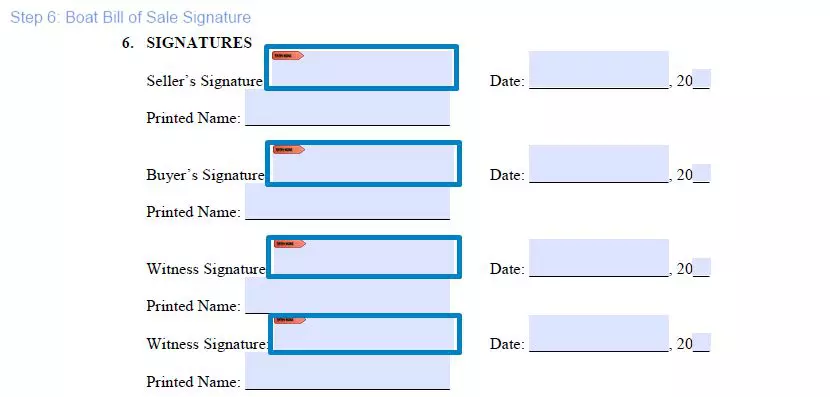
Step 7: Have a notary public attest the form
Despite the fact that notarization is almost never required, it can serve as one more way to safeguard against legal difficulties.
The purchaser will need to get the original document since it’s frequently required during the boat title transfer. As a seller, you could either create a copy and store it or have two identical forms signed and completed by both sides.


